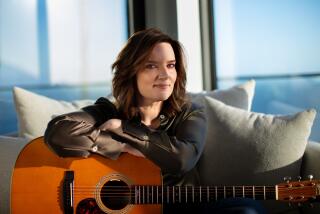The spin on ‘Bandstand’
- Share via
Fifty years ago today, at 3 p.m, “American Bandstand” made its debut on national television. In living rooms and rec rooms throughout the country, young viewers . were suddenly able to watch teenagers much like themselves dancing in Philadelphia (where the show was produced) to the same records that could be heard on their local Top 40 AM radio stations. And as they did, the baby boom generation came of age as an audience and a market -- and so did rock ‘n’ roll as a pervasive and enduring mass media phenomenon.
Consider: In 1957, the most successful songwriters on the pop charts were Jerry Leiber and Mike Stoller, authors of Elvis Presley’s “Jailhouse Rock” and the Coasters’ “Searchin’.” Only one year earlier, in 1956, the top songwriters had been Alan Jay Lerner and Frederick Loewe, composers of “My Fair Lady.”
Initially slated for a few what-the-hell weeks in the dog days of summer by the youngest television network with the least to lose, “American Bandstand” would run on ABC for 30 years (and longer in syndication and on cable), becoming the longest-running variety show in the history of television.
“American Bandstand” and its host, Dick Clark, whose baby face belied his grown-up jacket and tie, had an indelible effect on popular music. They made stars of performers such as Connie Francis, Bobby Darin and Neil Sedaka, who appeared frequently on the show. Propinquity and heavy promotion turned such local talents (or non-talents) as Francis Avallone, Robert Ridarelli and Fabian Forte into teen idols Frankie Avalon, Bobby Rydell and, simply, Fabian.
When Clark encouraged a former chicken plucker named Ernest Evans to cover an obscure R&B; B-side by Hank Ballard and the Midnighters, he sparked and promoted America’s greatest dance craze since the Lindy Hop: the Twist. (It was Clark’s wife who dubbed Evans “Chubby Checker.”)
But that’s Rock History 101, now enshrined in college curricula throughout the nation. (This year’s No. 1 NBA draft pick, Greg Oden, took it at Ohio State before turning pro.) What’s less acknowledged is “American Bandstand’s” enduring influence on television to this day.
Take reality TV. What could be more real or banal than watching kids from South Philadelphia High School, who might just as well be your classmates in Kalamazoo or Klamath Falls, do the Stroll or the Watusi? Airing every weekday afternoon and, for a while, on Saturday night as well, “American Bandstand” exalted the everyday. Teenage dancers who appeared regularly, like Bob and Justine and Kenny and Arlene, attracted fans who followed their romances, hairstyles and wardrobes as closely as viewers of MTV’s “The Real World” tracked their favorite slackers and sluts 35 years later.
The show’s “Rate-a-Record” routine was a low-tech “American Idol,” as the dancers judged the discs. “The beat was OK,” one might opine, “but a bit too slow.” Practicing looks in the mirror or moves with friends (this article goes out to Verena Taylor and Laura Goodrich, wherever you are), a teenager could aspire to the highest common denominator of low, democratic culture. “American Bandstand” was the pilot for today’s celebrity ballroom dancing and everyman karaoke, and it was even cheaper to produce. Remember, the “reality” in reality TV refers not to cinéma vérité but to the bottom line.
Of course, “American Bandstand” was never real. The performers lip-synced to their records. (On the opening show, Billy Williams mouthed “I’m Gonna Sit Right Down and Write Myself a Letter,” and the Chordettes mimed “Just Between You and Me.”) Clark, despite having grown up next door to Arthur Murray in Mount Vernon, N.Y., couldn’t dance, and he cared so little about music that when Edward R. Murrow came calling to film a feature for his television interview show, “Person to Person,” Clark hastily had record shelves installed in his house and stocked them with empty sleeves cadged from record promoters.
What Clark cared about was money. In a 1976 memoir, he confessed to having “the heart of a cunning capitalist.” Surely there’s no sin in that. Yet Clark insisted to a House subcommittee in 1960 that “I believe in my heart that I have never taken payola.” This despite the fact that his interests in record and publishing companies and gifts from people eager or grateful for airplay on “American Bandstand” had made him a millionaire and inspired the coinage “Clarkola.”
The teenagers who rated records on “American Bandstand” were earnest in their opinions, but the process that determined which records and performers were featured on the program in its early years was as rigged as the questions Charles Van Doren answered on “Twenty-One.” Indeed, it was the quiz-show scandal that led to the payola investigation.
Clark’s clean-cut demeanor and protestations of innocence helped him emerge nearly unscathed from the payola hearings, and to go on to prosper as “America’s oldest living teenager.” He hosted one version of “American Bandstand” or another until 1988. Even a stroke in 2004 has not deterred him from continuing to ring in the New Year in Times Square on TV.
But Clark’s prescience is even more remarkable than his eternal youth. His genius was to grasp, 50 years ago on “American Bandstand,” how profitably television can market and manipulate reality.
More to Read
The complete guide to home viewing
Get Screen Gab for everything about the TV shows and streaming movies everyone’s talking about.
You may occasionally receive promotional content from the Los Angeles Times.






